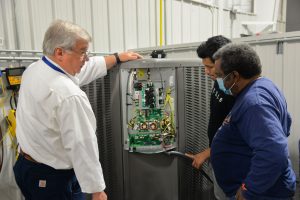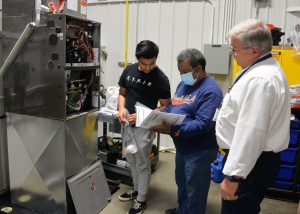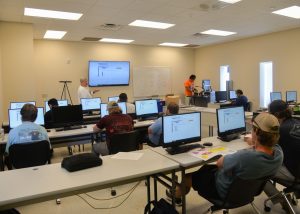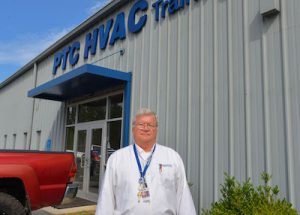HVAC Program Director to Put Students ‘On the Vanguard of What’s Coming’
August 10, 2022Comfort can be as individual to a person as their fingerprint. The constant tug-of-war around office thermostats in decades past is evidence of that. And thanks to 21st century heating, ventilation, and air conditioning (HVAC) technology, consumers no longer must sacrifice to enjoy their personally perfect climate every day. Piedmont Technical College (PTC) HVAC Program Director Robbie Hill, a 50-year veteran of the industry, says that today’s HVAC most certainly is not your grandfather’s HVAC.
 “When I started in the industry, people didn’t really do heating and cooling. They turned the AC off on Memorial Day and turned it back on around Labor Day,” he said. “Today we use HVAC for what it was designed for — continuous comfort. It has been a real big change.”
“When I started in the industry, people didn’t really do heating and cooling. They turned the AC off on Memorial Day and turned it back on around Labor Day,” he said. “Today we use HVAC for what it was designed for — continuous comfort. It has been a real big change.”
Hill has watched HVAC evolve over the years, driven largely by energy and environmental concerns. Refrigerants originally used in the 19th century, unfortunately, were toxic and for that reason not sustainable. By the 1950s, less toxic chlorofluorocarbons (CFCs) became the go-to refrigerant. However, in the 1990s, concerns about CFCs depleting the earth’s protective ozone layer led to the phasing out of CFCs in favor of less harmful refrigerants, such as 410A refrigerant, also sold as the brand Puron®, which was believed to be less harmful to the ozone. With so much at stake with handling refrigerants, new EPA Clean Air Act amendments passed in 1990 mandated that all HVAC technicians have Section 608 certification on refrigerant handling and safety by 1995.
“Over time, they realized that, while 410A and its family of refrigerants were less harmful to the ozone, they still had the potential to cause harm when it came to global warming,” Hill explained, “so the industry needed to rethink refrigerants once again.”
 Currently, the standard is moving toward non-toxic, cost-efficient, less-flammable A2L refrigerants, which will be required by 2025. “We were still using refrigerants that are very flammable. … Now I am teaching A2L refrigerants, because when our students get out of school, that is what they will be dealing with.”
Currently, the standard is moving toward non-toxic, cost-efficient, less-flammable A2L refrigerants, which will be required by 2025. “We were still using refrigerants that are very flammable. … Now I am teaching A2L refrigerants, because when our students get out of school, that is what they will be dealing with.”
A determined Hill took the proverbial refrigerant cylinder by the handle and ran with it, proposing wide-ranging changes to the HVAC curriculum at PTC. The plan was approved in June, and the updated curriculum will be implemented this fall.
Among the changes will be less time in lectures and more time in hands-on learning, including online virtual reality simulation.
“We are changing the way we teach,” Hill said. “We are introducing an innovative online tool called ‘Interplay.’ It features easily digestible 5-7-minute lessons followed by a test on the knowledge and a guided 3-D troubleshooting simulation. Once those guided simulations are done, students have the opportunity to complete the simulation on their own, and it is graded. …
“We want to reach students where they are. They have been gaming their whole lives. So it makes sense to update courses and delivery methods.”
Hill believes that many HVAC students who work full-time jobs already are tired when they attend a five-hour classroom lecture in the evening. He knew there had to be a better way. That’s why he proposed reducing the late-night lecture time in favor of much more hands-on and hybrid engagement. He reasons the lectures can be delivered in recorded virtual format, but lab time cannot. So the class delivery not only will feel fresher to students but also be more stimulating and targeted to the latest industry needs.
 Updated courses, Hill said, allow for better integration of new technologies, reduce late-night classroom time, offer students smaller blocks of information for improved pacing and retention, offer additional lab-based troubleshooting opportunities, increase focus on the latest field requirements, and frequent assessments enable training to be more fluid and individualized.
Updated courses, Hill said, allow for better integration of new technologies, reduce late-night classroom time, offer students smaller blocks of information for improved pacing and retention, offer additional lab-based troubleshooting opportunities, increase focus on the latest field requirements, and frequent assessments enable training to be more fluid and individualized.
Once students have mastered their simulation exercises, Hill added, they can work on real-world equipment with actual electricity powering it. The safety of trying to test and troubleshoot circuits first will be extremely valuable.
“I want to give them what the employers are telling me they want,” he said. “Next semester, our students will be installing new equipment. They will be on the vanguard of what’s coming.”
For more information about PTC’s HVAC Program, visit www.ptc.edu/hvac.
- PTC HVAC Program Director Robbie Hill
- Hill provides instruction in the classroom.
- Hill assists students in a lab exercise.













